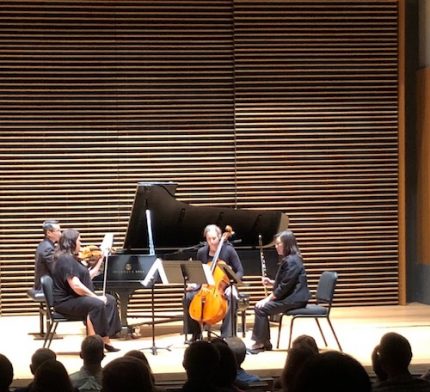Picosa opens new DePaul series with a varied chamber feast

Picosa’s concert Tuesday night offered more than a deep dive into contemporary chamber music. It was also the first concert in a new Picosa series this season at Allen Recital Hall, one of several theaters in the handsome new Holtschneider Performance Center on DePaul University’s Lincoln Park campus. Judging from Tuesday’s performance that ranged from George Crumb to Jennifer Higdon, the ensemble and the new hall will be making beautiful music together.
With just 140 seats, the Allen is an intimate room, but its soaring ceiling and generous legroom make it feel airy and spacious. Basically a wood-lined rectangle, its sleek, modernist lines are soothing, inviting us to put aside distractions and immerse ourselves in the music onstage. Especially in Luciano Berio’s Sequenza IX for solo clarinet and George Crumb’s Vox Balaenae (Song of the Whale), the music, enhanced by the hall’s clear but full-bodied acoustic, was mesmerizing.
In Sequenza IX, clarinetist Andrea R. DiOrio riveted our attention from the first moment, unleashing a cluster of quick notes that, although hushed, blossomed in the hall.Bursting with lavish coloratura flights and quiet, long notes, Sequenzademands a virtuoso clarinetist, and DiOrio effortlessly filled that role. Her tone was powerful and rounded whether leaping to clarion high notes or sinking into mournful depths.

The piece is episodic, and DiOrio managed to pour meaning into the silences that separate its explosive outbursts. We waited breathlessly, not knowing what to expect but never losing the sense of a through line, an underlying architecture holding the piece together.
Silence was equally powerful in Crumb’s Song of the Whale, composed in 1971 for flute, cello and piano. The sinuous, breathy melodies from Jennie Oh Brown’s flute seemed to rise from a vast, silent ocean. Paula Kosower’s cello sent out raspy but resonant melodic fragments that lingered in the air like eerie, erratic calls from unknown creatures moving through unfathomable depths. At times the keening, swooping cello evoked wheeling seagulls, and steady chords and single notes from Kuang-Hao Huang’s piano often served as a dark, shadowy anchor.
Composer Chinary Ung was in the audience for his Child Song for flute, violin, cello and piano. Born in Cambodia and long based in the U.S., Ung blends eastern and western influences in his music. With its folk-inflected melodies and frequent yet unthreatening dissonances, Child Song unfolded like a seamless hallucination. Bits and pieces of clearly defined color occasionally came into focus. At one point, the playful, sing-song runs of violinist Elizabeth Brausa Brathwaite shifted into something more wary and astringent. Mostly, however, the atmosphere was more evanescent. Like a dream, the interplay of instruments was unpredictable yet somehow entirely logical.
Nico Muhly’s urgently driven Common Ground for violin, piano and cello opened the concert. Like super-charged children on a playground Brathwaite, Kosower and Huang were intensely focused, jockeying for position, sometimes hurling taunts among themselves, sometimes seamlessly trading places. At one moment Kosower’s cello was quietly singing a melancholy; the next she was screaming a vociferous complaint. Huang’s piano was sometimes skittering and high-strung, a kid itching to join the game. At others, he was the adult monitor, conspicuous yet calm, pacing steadily in the background.
The concert ended with Smash, a brief piece by Jennifer Higdon for flute, clarinet, violin cello and piano. If Common Ground brought to mind children on the playground, Smash conjured a crowd of crazy-busy adults. Picosa tore through its short, tense phrases with cheerful single-mindedness. Each player focused obsessively on a different musical path, abruptly starting and stopping, constantly changing directions. They were as driven as commuters racing for a train, parents late for a school pickup, baristas working the early-morning, double-espresso rush. Frantic moments of our lives–“Great to see you! Gotta run!”–deftly set to music
Posted in Uncategorized




